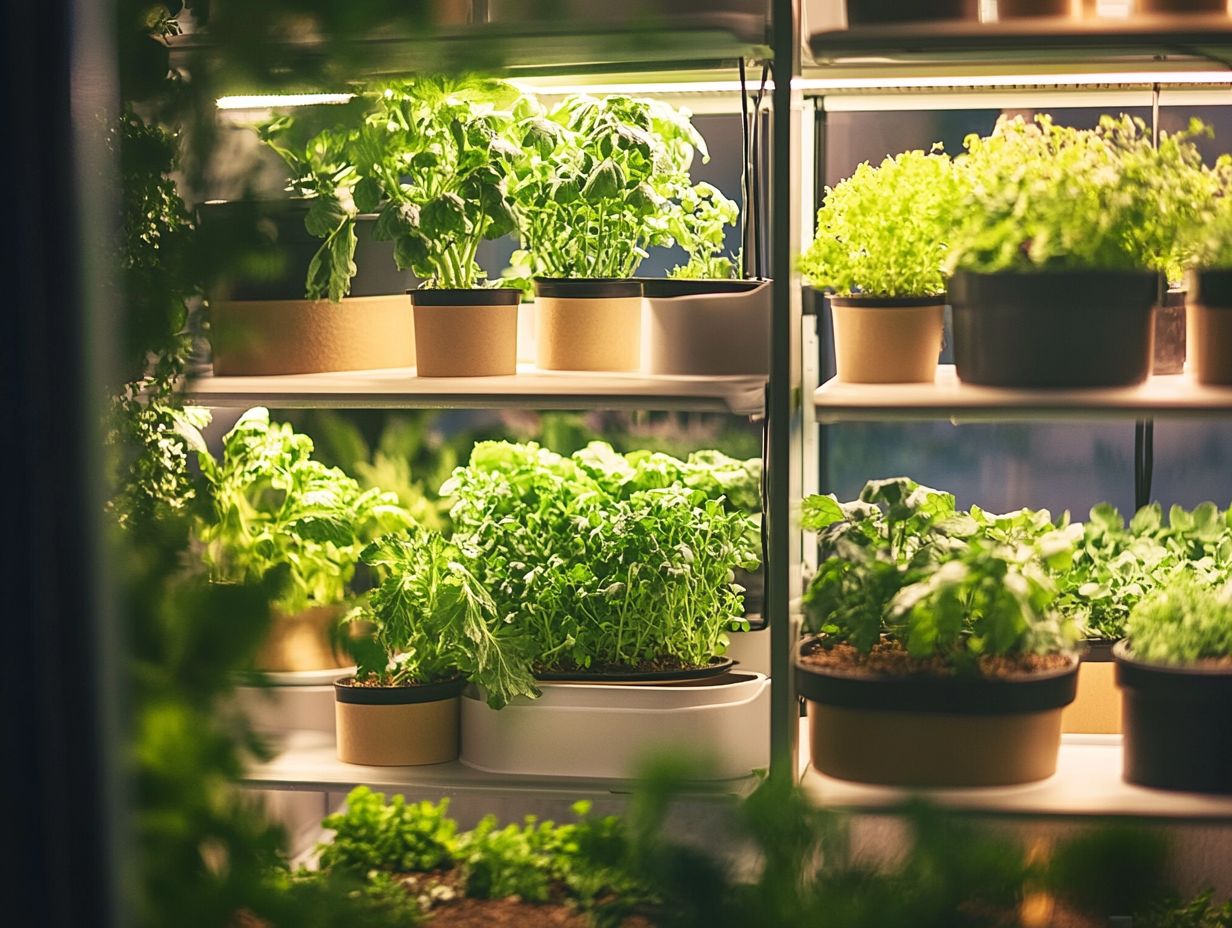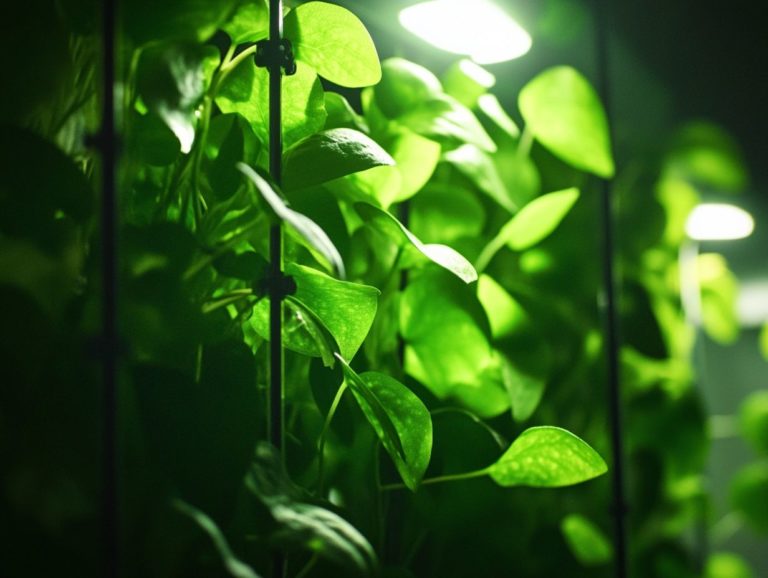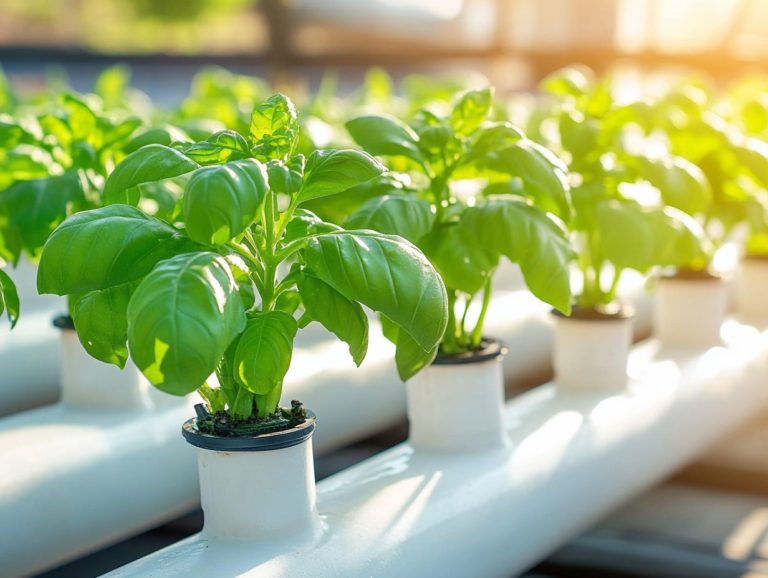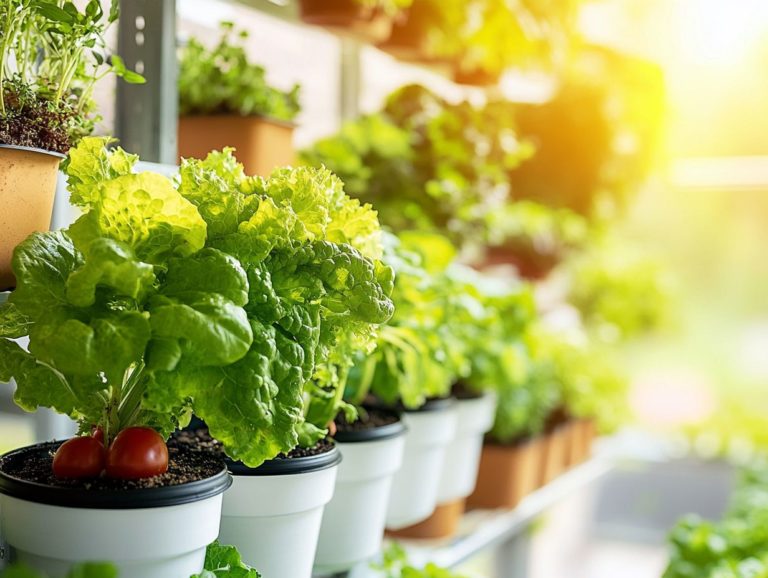“Hydroponic Gardening: What to Grow in Pots”
Hydroponic gardening is redefining the way you approach plant cultivation! You can nurture vibrant greenery without the constraints of traditional soil.
Whether you’re constrained by limited space or eager to venture into a new gardening technique, growing in pots presents a wealth of advantages. From effortless maintenance to greater control over nutrient management, container gardening is perfect for city dwellers! You can grow your food even in small spaces.
This comprehensive guide will equip you with the essentials of hydroponic gardening. We ll cover suitable plants, setup instructions, and invaluable tips to ensure your garden flourishes.
Immerse yourself in this journey and uncover how you can craft your very own hydroponic oasis!
Contents
- Key Takeaways:
- Benefits of Growing in Pots
- Plants Suitable for Hydroponic Gardening in Pots
- How to Set Up a Hydroponic Garden in Pots
- Tips for Maintaining a Healthy Hydroponic Garden
- Proper Nutrient Balance
- Preventing and Treating Pests and Diseases
- Frequently Asked Questions
- What is hydroponic gardening?
- Why should I grow plants in pots for hydroponic gardening?
- What types of plants can I grow in pots using hydroponic gardening?
- Do I need any special equipment for hydroponic gardening in pots?
- How do I maintain the nutrient levels in my hydroponic gardening pots?
- Can I reuse the nutrient solution in my hydroponic gardening pots?
Key Takeaways:

- Hydroponic gardening is a soilless method of growing plants in nutrient-rich water, making it efficient and easy to maintain.
- Container gardening offers numerous benefits, including space-saving, flexibility, and portability.
- Herbs, vegetables, flowers, and fruits can thrive in a hydroponic garden, providing various options for homegrown produce.
What is Hydroponic Gardening?
Hydroponic gardening presents an innovative way for you to grow plants without the hassle of soil. Instead, you ll utilize a nutrient-rich water solution to nourish the roots, enabling you to cultivate a variety of plants, from vegetables to herbs, in a clean, controlled environment.
This method ensures optimal growth year-round, regardless of the season. By eliminating traditional soil, hydroponics provides an efficient means to achieve high-quality yields, making it appealing for home gardeners and commercial growers.
The principles of hydroponic gardening focus on supplying essential nutrients directly through the water. This promotes faster and healthier growth compared to conventional methods. This method has been used since ancient times. The Nutrient Film Technique (NFT) is a method where a thin stream of nutrient-rich water is circulated over plant roots, maximizing efficiency.
Hydroponics supports sustainable practices by reducing water usage and minimizing pesticide reliance. This approach effectively addresses food security challenges in urban settings. When you compare hydroponic gardening to conventional soil-based methods, the former often yields higher outputs, shorter growth cycles, and a more efficient use of space and resources.
Benefits of Growing in Pots
Growing in pots presents a host of advantages, especially for those eager to cultivate plants, vegetables, and herbs in limited spaces. This approach grants you enhanced control over the growing environment, simplifying the monitoring of water and nutrient levels while ensuring efficient resource use.
Potted plants often deliver richer yields with minimal effort, as they flourish in a customized setup that safeguards against pests and diseases. Enjoy fresh produce year-round, regardless of outside conditions!
Advantages of Container Gardening
Container gardening presents a multitude of advantages, making it an enticing option for both novice and seasoned gardeners eager to cultivate herbs and vegetables in a controlled setting. This method allows you to manage soil quality, moisture, and nutrients with precision, ensuring optimal care for your plants while sidestepping the challenges associated with traditional in-ground gardening.
The flexibility to position your plants strategically allows you to capture maximum sunlight and minimize the risk of pests and diseases. You ll appreciate the distinct advantage of easily moving pots to find the perfect light or shade, especially if you’re working with limited space or in an urban environment.
Selecting the right containers is paramount. Always choose those with drainage holes to prevent waterlogging and vary the sizes based on your plants’ specific needs. For soil mediums, opt for a lightweight potting mix enriched with organic matter to foster healthy growth.
Incorporating companion planting within these containers can elevate your pest management strategy, as certain plants naturally repel pests that might otherwise threaten their neighbors.
Start your hydroponic garden today and share your experiences!
Plants Suitable for Hydroponic Gardening in Pots
A diverse array of plants is perfectly suited for hydroponic gardening in pots, allowing you to maximize your yields and savor fresh produce year-round.
You might consider popular options like leafy greens think lettuce, spinach, and kale alongside aromatic herbs such as basil and cilantro. Many enthusiasts also find success growing fruit-bearing plants like tomatoes, cucumbers, and peppers, all benefiting from the nutrient-rich water systems that hydroponics offer.
This remarkable flexibility gives you the power to cultivate a variety of crops in compact spaces, harnessing optimal conditions for growth and making your gardening experience both rewarding and efficient.
Herbs and Vegetables

Herbs and vegetables stand out as some of the finest choices for hydroponic gardening, allowing you to cultivate fresh and flavorful produce right in the comfort of your home. Varieties like basil and cilantro thrive in nutrient-rich solutions, delivering vibrant flavors and enticing aromas.
Leafy greens such as lettuce and kale flourish in hydroponic systems, offering an efficient way to enjoy healthy salads and dishes year-round, all while minimizing the hassle of traditional soil care.
Herbs like mint and parsley adapt exceptionally well to hydroponic setups, requiring moderate light and specific pH levels for optimal growth. These plants not only enhance the taste of your culinary creations but also offer a wealth of health benefits, such as aiding digestion and boosting immunity.
Incorporating these fresh herbs into dishes like tabbouleh or pesto can truly elevate your meals with their zest and vibrancy. Meanwhile, vegetables like tomatoes and peppers thrive when nurtured in a well-balanced nutrient solution.
They produce juicy results perfect for a variety of recipes, including homemade salsa or stuffed peppers, enriching both your diet and culinary adventures.
Flowers and Fruits
Along with herbs and vegetables, hydroponic gardening opens the door to a delightful array of flowers and fruits, making it a versatile option for you as an enthusiast. Take strawberries, for example. You can easily cultivate them in pots using hydroponic systems, reaping the rewards of sweet, juicy fruit throughout the growing season.
Fruit-bearing plants like tomatoes, cucumbers, and peppers flourish in these controlled environments, allowing you to enjoy abundant harvests without the headaches that often accompany traditional gardening.
Among the popular hydroponic flowers, orchids and chrysanthemums stand out, bringing vibrant colors and enchanting fragrances to your space. These beauties require specific light and nutrient conditions that you can easily customize in a hydroponic setup to boost their blooming potential.
To grow your plants successfully, you need to maintain proper pH levels and nutrient concentrations while ensuring adequate airflow and humidity control. Techniques like vertical gardening can help you maximize space, enabling a delightful variety of plants to thrive.
By experimenting with different species such as dwarf sunflowers or sweet basil in bloom you can turn your hydroponic garden into a vibrant, productive paradise!
How to Set Up a Hydroponic Garden in Pots
Establishing a hydroponic garden in pots demands careful planning and the right equipment to guarantee optimal growth and efficiency. Start by selecting pots that are perfectly suited to accommodate the roots of your chosen plants, ensuring they have ample space to thrive.
Key equipment will include a container for the nutrient mix, a reliable pump for water circulation, and lighting systems designed to replicate natural sunlight. By mastering the configuration of these essential components, you can cultivate a thriving growing environment that maximizes your yields while minimizing the effort required.
Get started today and watch your garden thrive!
Equipment and Supplies Needed
To successfully establish your hydroponic garden in pots, you’ll need several essential pieces of equipment and supplies. These items facilitate optimal plant growth and nutrient absorption.
- Pots that ensure proper drainage and ample root space,
- A reliable nutrient solution packed with essential minerals,
- A pump for efficient water circulation.
Proper lighting is crucial. It simulates sunlight and provides your plants with the necessary light for photosynthesis.
Other important supplies involve:
- A timer to regulate your lighting schedule,
- A pH meter to monitor the acidity of your nutrient solution crucial, as it can significantly impact nutrient availability,
- Grow media, such as coconut coir or rock wool, which are vital as they offer support while retaining moisture and air.
When selecting equipment, pay careful attention to factors like the scale of your setup whether it’s a small home project or a larger endeavor as well as the types of plants you wish to cultivate and your available budget. This thoughtful approach will ensure everything aligns perfectly with your specific gardening goals.
Step-by-Step Guide
Creating a hydroponic garden in pots is a rewarding venture. It requires a systematic, step-by-step approach.
Begin by selecting the right pots and finding the ideal location for your garden.
Next, prepare a nutrient solution tailored to the specific needs of your chosen plants. Set up your lighting system and pump, ensuring that water circulates efficiently throughout the system.
After that, plant your seeds or seedlings in the pots, and monitor their progress regularly for optimal yields and health.
Understanding the type of hydroponic system you wish to implement is essential. Options include deep water culture, nutrient film technique, or wick systems.
It s crucial to select pots with adequate drainage and to arrange them to maximize light exposure.
As you mix your nutrient solution, pay close attention to pH levels and make adjustments to prevent plants from not absorbing nutrients.
Regularly check nutrient levels in your water solution and adjust as needed to meet your plants’ specific needs. Stay vigilant for any signs of pests or nutrient deficiencies. Don t hesitate to make adjustments based on your observations; every garden is unique and may require tailored strategies for optimal growth.
Your proactive approach will lead to a vibrant and flourishing hydroponic garden. Get ready to enjoy a bountiful harvest!
Tips for Maintaining a Healthy Hydroponic Garden

To cultivate a thriving hydroponic garden, it s crucial to embrace certain strategies that guarantee nutrient balance while safeguarding against pests and diseases.
Regularly checking the nutrient levels in your water solution is essential; by adjusting as needed, you cater to the specific needs of your plants.
Adopting preventive measures will elevate your gardening success. Keep your equipment pristine and monitor for pest signs to greatly increase your chances of a plentiful harvest.
Proper Nutrient Balance
Achieving the right nutrient balance is paramount for the success of your hydroponic garden. Plants depend on a precise mix of nutrients to thrive. Regularly testing and monitoring your nutrient-rich water is essential; ensure it aligns with the specific needs of your plants and adjust concentrations as they progress through different growth stages.
Maintaining an optimal nutrient balance promotes healthy development, maximizes yields, and enhances the quality of your harvest.
In hydroponics, essential nutrients include macronutrients, which are the primary nutrients needed in larger quantities, and micronutrients, which are necessary in smaller amounts. Macronutrients like nitrogen, phosphorus, and potassium support overall growth, while micronutrients such as iron, magnesium, and calcium play crucial roles in specific functions, such as root development and flowering.
To avoid deficiencies, utilize pH test kits or EC meters to closely monitor nutrient levels. If you detect a deficiency, make gradual adjustments to your nutrient mix to prevent shocking your plants.
Remember, precise nutrient management is key. Overlooking even one essential element can hinder growth and diminish vitality.
Preventing and Treating Pests and Diseases
Preventing and treating pests and diseases is vital for maintaining a thriving hydroponic garden, as these issues can significantly affect plant health and yields. Regularly monitor for signs of infestations or disease symptoms, allowing you to act swiftly when problems arise.
Implement preventive measures, like maintaining a pristine environment and using organic pest control solutions, to substantially reduce the risk of pests and diseases. This ensures your garden remains vibrant and productive.
Stay vigilant for common pests such as aphids, spider mites, and whiteflies, which can quickly undermine your gardening efforts. Integrate pest management techniques, such as introducing beneficial insects or applying neem oil, to cultivate a balanced ecosystem. Early detection is key; often, spotting a minor infestation can prevent a full-scale outbreak.
Employing strategies like crop rotation and ensuring proper nutrient balance can enhance plant resilience and maintain the overall health of your hydroponic system. By prioritizing proactive care, you can effectively safeguard your plants against potential threats and pave the way for a bountiful harvest.
Frequently Asked Questions
-
What is hydroponic gardening?
Hydroponic gardening is a method of growing plants without soil. Instead, plants are grown in a nutrient-rich water solution, allowing for faster and more efficient growth.
-
Why should I grow plants in pots for hydroponic gardening?
Growing plants in pots for hydroponic gardening offers a compact and space-saving solution, making it ideal for urban areas or small living spaces. It also allows for easier maintenance and customization of nutrient levels for different plants.
-
What types of plants can I grow in pots using hydroponic gardening?
A wide variety of plants can be grown in pots using hydroponic gardening, including leafy greens, herbs, fruits, and vegetables. It’s important to research the specific needs and requirements of each plant to ensure successful growth.
-
Do I need any special equipment for hydroponic gardening in pots?
While various systems and equipment are available for hydroponic gardening, all you need to get started is a pot, growing medium, and nutrient solution. Consider using LED grow lights to supplement natural light for indoor gardening.
-
How do I maintain the nutrient levels in my hydroponic gardening pots?
Monitoring and adjusting nutrient levels is key to successful hydroponic gardening. Use a pH meter and nutrient testing kit to regularly check and adjust the levels as needed. Regularly cleaning and flushing your system is crucial for preventing problems!
Are you ready to create your own thriving hydroponic garden?
Can I reuse the nutrient solution in my hydroponic gardening pots?
Yes, you can reuse the nutrient solution in your hydroponic gardening pots. Just monitor the levels to make sure your plants get the right nutrients.
Replace the solution completely after a few uses. This will help prevent nutrient shortages or harmful build-up. Keep your plants happy and thriving!







